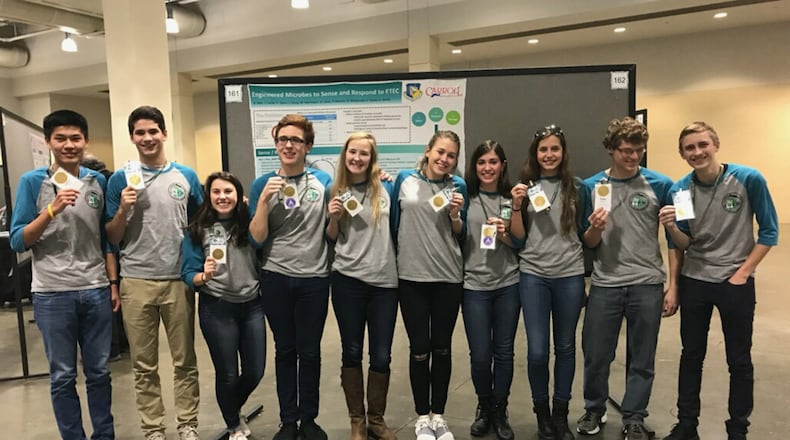“This research aligns seamlessly with the tri-service (Army, Navy and Air Force) Synthetic Biology for Military Environments initiative that many researchers within AFRL are involved with,” explained Dr. Michael Goodson, an iGEM mentor and research scientist with AFRL’s 711th Human Performance Wing. “The most prevalent disease affecting our deployed service members is traveler’s diarrhea. The biological machine that our iGEM team designed would detect the traveler’s-diarrhea-caused bacteria ETEC and indicate its presence by glowing green. It could be put into water sources and even within the gastrointestinal tract to give an early warning of ETEC infection.”
The Office of the Secretary of Defense sponsored this team under the Applied Research for the Advancement of Science and Technology Priorities program in Synthetic Biology for Military Environments.
“Synthetic biology is an emerging area of research that can be broadly described as the design and construction of novel artificial biological pathways, organisms or devices, or the redesign of existing natural biological systems,” according to the United Kingdom Royal Society. A common example of a microorganism that can be introduced into the body is a probiotic, which consists of live bacteria and yeasts that benefit the digestive system.
The team competed with 337 teams from around the world, and was one of 47 high school teams. It was the only team from Ohio, and was one of two teams from the United States to earn gold.
“This is the first year OSD and AFRL sponsored an iGEM team so everyone involved was a trailblazer,” Goodson said. “The dedication, diligence and flexibility of the team, especially the students, was essential to the success of the team. They worked above and beyond our wildest expectations; they ‘grasped the nettle’ and took possession of the project. The lab portion of the project is only one part of the final submission; there are other components related to public outreach, collaboration with other teams, and design of a wiki page. The students performed all of these with minimal guidance and assistance from the mentors.”
Matthew Sableski, the CHS principal explained that the experiences afforded to these students were vast, being able to compete with hundreds of teams on an international stage.
“The AFRL-CHS iGEM team collaborated with schools from London, Singapore, Denmark and Michigan, to name a few,” Sableski said. “At the competition they met other (Department of Defense) teams from West Point, the U.S. Naval Academy and a team sponsored by the Army. They consulted with high school, under-graduate and post-graduate students.”
Goodson explained that teams from all over the world were sharing their success and failures during the event in order to push and encourage each other.
“The energy associated with the event was palpable. Our students were meeting up with each other, and other teams, to animatedly discuss the amazing breakthroughs and creative problem solving they had just witnessed in each presentation. Speaking personally, it has been one of the most inspiring and uplifting moments in my AFRL career, and I think that sentiment was shared by all the members of the team,” said Goodson.
The CHS team were all students at Carroll High School when the team was started back in May 2017, explained Goodson. Originally, the team consisted of then-seniors Tina Davis, Dallas McDonald, Andrea Poole, and Angela Smith; then-juniors Jason Dong and Peter Menart; and then-sophomores Annie Bete, Jonah Carter, Max Herrmann and Hayley Jesse.
Those seniors are now college students, all attending universities in Ohio. Andrea Poole and Tina Davis attend Wright State University; Dallas McDonald, Case Western Reserve University; and Angela Smith, University of Cincinnati.
“These young people went from not knowing one end of a micropipette from the other to fielding and confidently answering questions from world-renowned leaders in synthetic biology in only seven months,” Goodson said. “I am confident they will become the leaders of the future and, based on this evidence, the future is bright.”
Mentors from CHS were Drs. Martha Carter, Caroline Dickey and Chrissy O’Malley. Mentors from AFRL were Dr. Nancy Kelley-Loughnane with 711th HPW and Dr. Wendy Goodson with the Materials and Manufacturing Directorate as well as AFRL UES Inc. contractors Drs. Michael Goodson, Chia Hung, Vanessa Varaljay and Rachel Krabacher.
Having a successful team takes a village, though, and many other research scientists from the Materials and Manufacturing Directorate and the 711th Human Performance Wing were involved, Goodson said.
“The iGEM experience has planted seeds that no doubt will bloom with the promise of the next generation of scientists,” said Sableski.
About the Author
